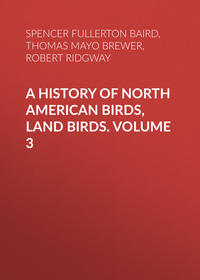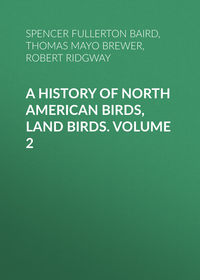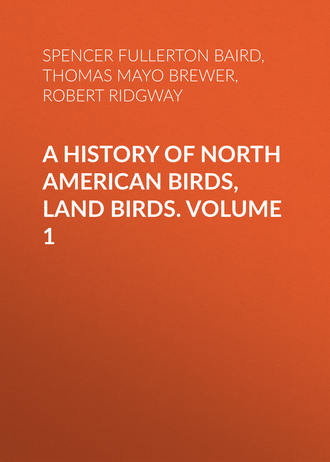 полная версия
полная версияA History of North American Birds, Land Birds. Volume 1
A striking peculiarity of these nests is frequently an extra platform, built against, but distinct from the nest itself, designed as a roosting-place for the parents, used by one during incubation at night or when not engaged in procuring food, and by both when the young are large enough to occupy the whole nest. One of these I found to be a separate structure from the nest, but of similar materials, three inches in length and one and a half in breadth. This nest had been for several years occupied by the same pair, though none of their offspring ever returned to the same roof to breed in their turn. Yet in some instances as many as fifty pairs have been known to occupy the rafters of the same barn.
In one instance Mr. Allen has known a pair of these Swallows to take possession of the nest of a pair of Cliff Swallows, placed under the eaves of a barn, driving off the rightful owners. The next year they built a nest in the same place, the old one having fallen down. But such instances are rare, and the attempt is often a failure.
The wonderful activity of this bird, its rapidity and powers of flight, are too striking a peculiarity of this species not to be mentioned. During their stay with us, from May to September, from morn to night they seem to be ever in motion, especially so before incubation, or after their young have flown. The rapidity of their tortuous evolutions, their intricate, involved, and repeated zigzag flights, are altogether indescribable, and must be witnessed to be appreciated. Wilson estimated that these birds fly at the rate of a mile a minute, but any one who has witnessed the ease and celerity with which they seem to delight in overtaking, passing, and repassing a train of cars moving at the rate of thirty miles an hour must realize that this estimate is far from doing full justice to their real speed.
The song of this Swallow, especially when on the wing, is very pleasing and sprightly. It is a succession of twittering notes uttered with great rapidity and animation. When alighted, their notes are delivered more slowly and with much less animation.
The attention of these birds to each other when sitting upon the nest, and to their young when hatched, is unremitting. The estimated numbers of small insects they collect for their own consumption and that of their nestlings is almost incredible. When the young are old enough to leave their nests the manœuvres of the parents to draw them out, and their assistance to them when practising their first short flights, are among the most curious and interesting scenes one can witness in his ornithological experiences; but space would fail me were I to attempt their details.
The number of the young is from four to six, and there are often two broods in a season. As soon as the second brood can fly, or early in September, they all prepare to leave. They usually collect in flocks of from one to several hundred, and depart within a few days of their first assembling. Large flocks pass along the coast of Massachusetts, from the north and east, early in September, often uniting as they meet, and passing rapidly on.
Their eggs have a ground-color of clear white, with a roseate tint when unblown. They are marked with spots of reddish and purplish-brown, varying in size and number, and chiefly at the larger end. They are smaller and more elongate than those of the lunifrons, and the markings are usually finer. Their greatest length is .94 of an inch, their least .75, and their mean .78. Their mean breadth is .56 of an inch, the greatest .62, and the least .50.
Subgenus TACHYCINETA, CabTachycineta, Cab. Mus. Hein. 1850, 1851, 48. (Type, H. thalassina, Sw.)
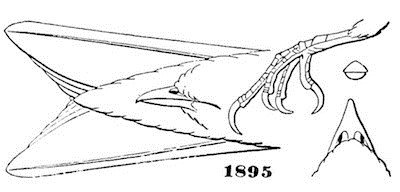
Hirundo thalassina.
1895
Gen. Char. Nostrils lateral, overhung or bordered internally by incumbent membrane. Tarsi with the tibial joint covered by overhanging feathers, adherent a short distance along inner face, about equal to middle toe without claw. Lateral toes equal. Adhesion of basal joint of middle toe variable. Tail emarginate only, or slightly forked; fork not exceeding half an inch in depth. Color blue or green above, with or without metallic gloss; with or without white rump. Entirely white beneath. Nest usually in holes of trees or rocks; eggs pure white, unspotted.
Of this section there are two North American species, differing as follows, both being green above and white beneath:—
SpeciesPlumage above soft and velvety without metallic gloss. Sides of head, space around eyes, and whole under parts, white; with the feathers all plumbeous at base. Female duller in plumage. Young with bases of throat-feathers gray to roots.
T. thalassina. Above velvety-green, with various shades and tinges of violet and purple.
Plumage above compact, and with rich green metallic gloss. Sides of head to line with eyes like its upper part. Beneath white; the feathers of chin and throat, and generally of crissum, white to base. A concealed spot in jugulum. Female duller. Young with bases of throat-feathers pure white to roots.
T. bicolor. Above metallic-green. Inside of wings and axillars ash-color.
Hirundo bicolor, VieillWHITE-BELLIED SWALLOWHirundo bicolor, Vieill. Ois. Am. Sept. I, 1807, 61, pl. xxxi.—Aud. Orn. Biog. I, pl. xcviii.—Ib. Birds Am. I, pl. xlvi.—Cassin.—Brewer, N. Am. Oöl. I, 1857, 100, pl. iv, fig. 47 (eggs).—Lembeye, Aves de Cuba, 1850, 46, lam. vii, fig. 2.—Baird, Birds N. Am. 1858, 310.—Lord, Pr. R. A. Inst. Woolwich, IV, 1864, 15 (Br. Columbia; nesting).—Jones, Bermudas, 34 (Sept. 22, 1849).—Cooper & Suckley, P. R. R. Rep. XII, II, 184.—Dall & Bannister, 279 (Alaska).—Samuels, 257.—Cooper, Orn. Cal. 1, 1870, 106. Petrochelidon bicolor, Sclater, P. Z. S. 1857, 201.—Ib. 1859, 364 (Xalapa).—Sclater & Salvin, Ibis, 1859, 13 (Guatemala). Tachycineta bicolor, Cab. Mus. Hein. 1850, 48; Jour. Orn. 1856, 4 (Cuba).—Gundlach, JJour. Orn. 1861, 330 (common in Cuba). Hirundo (Tachycineta) bicolor, Baird, Rev. Am. B. 1864, 296. Hirundo viridis, Wils. Hirundo leucogaster, Stephens.
Sp. Char. Glossy metallic bluish-green above; entirely white beneath. Female duller in color. Length, 6.25 inches; wing, 5.00; tail, 2.65.
Young bird dull sooty-gray above, much like that of H. thalassina; but may readily be distinguished by the feathers of the throat being pure white to their roots, instead of having the concealed bases grayish as in that species.
Hab. Whole United States, and north to Slave Lake, south to Guatemala; Bermuda; Cuba, common in winter. Breeds on table-lands of Mexico.
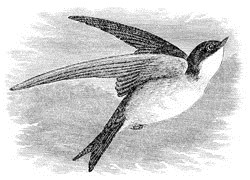
Hirundo bicolor.
Habits. This Swallow has quite an extended distribution. Found throughout North America in the seasons of its migrations, or breeding, it is only a little less restricted in its area of nesting than the preceding species. It breeds from latitude 38° to high Arctic regions, and is also resident throughout the year in the Plateau of Mexico. It is abundant in winter in the West Indies, in Central America, and in Northern South America. It is a common bird about Boston, where it replaces the Purple Martin, and is even more abundant in the British Provinces. Dr. Cooper also found it a very common species in the western portions of Washington Territory, where it was invariably found to breed in hollow trees. In California he states it to be a more or less constant resident, a few wintering in the southern portion of the State. He met with it both at San Diego and at Stockton, in February. He regards them as the hardiest of the Swallows, preferring the coast and the mountain-tops for their residence in that State. At Santa Cruz five or six pairs in 1866 were resident through the winter, where he saw them in January during the coldest of the season. They roosted in the knot-holes in the houses in which they had previously raised their young.
This Swallow, in the more thickly settled portions of the country in which it breeds, exhibits a marked departure in many of its habits from those observed in wilder regions. In the latter places we find it a comparatively wild species, avoiding the society of man, and breeding exclusively in hollow trees and stumps, and deserving the name by which it is known in the British Provinces, of the “Wood Swallow.” In the islands of Grand Menan, in 1851, where repeated attempts had been made to induce these birds to build in martin-boxes, the endeavor had been entirely unsuccessful. Yet the birds were so abundant that hardly a hollow tree or stump, on certain of the smaller islands, could be found, that did not contain a nest of this species. This is still the case on the Pacific coast, though not exclusively so. It was not until after the publication of his Ornithological Biography that Audubon was aware of any departure from this mode of nesting on the part of this Swallow, although it had not escaped the notice of Wilson.
In Eastern Massachusetts these birds have undergone an entire change of habit, breeding there exclusively in martin-boxes, and rarely, if ever, nesting in hollow trees,—a fact perhaps attributable to the scarcity of these opportunities along the sea-coast, where this bird is principally found. In Western Massachusetts, Mr. Allen states them to be not very common and the least abundant of the Swallows. Any sheltered and accessible box, however rough it may be, will answer its purpose, whether the more elaborate martin-house, or a mere candle-box with an open end. Mr. Audubon has known them to drive away a Barn Swallow from its nest, and to take possession, but this was probably exceptional. In one case, two small houses for birds put up in the same yard were taken possession of by a single pair of Swallows, and nests built in each; only one, however, of these was made use of. Whether this freak was the result of indecision or from a grasping selfishness, it is not possible to conclude, but apparently the former.
In the rural districts, even on the coast, these birds are not so abundant as in the cities, as in the latter they are less annoyed by other birds. The common Robin is often especially aggressive, seeking to drive them off his assumed premises. In one instance the Robin has been known to station himself on a platform in front of its nest for hours, and persistently refuse to permit its visits. Assistance was sought, and all the Swallows in the neighborhood came to the rescue. They sailed with angry cries over the head of the offender, at times darting down upon him as if to strike at him, but accomplishing nothing. The besieger maintained his ground until the writer intervened and drove him away, when the Swallows once more took possession, and fed their hungry nestlings in peace.
This species breeds from about latitude 38° to the extreme northern regions, and along the Arctic seas, wherever facilities for nesting are found. Richardson found them breeding in hollow trees on the Mackenzie River, in latitude 65°. Everywhere on both coasts they are very common, but are less numerous in the interior. Mr. Dall found it in Alaska from Fort Yukon to the sea. It was known to the Russians as the River Swallow. It was also met with in Sitka, by Bischoff. It has not been observed in Greenland.
During the breeding-season this species is more quarrelsome than any of its kindred, and is often more than a match for larger birds. Coming earlier in the season than the Purple Martin, it will often intrude itself into its premises and maintain possession. They are devotedly attached to their offspring, and bewail any accidents to them or any threatened peril. The same pair will return year after year to the same premises, and they soon become on familiar terms with the members of a family they frequently meet, so much so as to watch, when they have received materials for their nests, for a further supply, and will fly close to the person from whom they receive them. A pair which had thus, year after year, received supplies of feathers for their nests from the younger members of the family in whose yard their nest was built, would almost take them from the hands of their providers. This pair sat so close as to permit themselves to be taken from their nest, and when released would at once fly back to their brood. They build a loose, soft, and warm nest of fine soft leaves and hay, abundantly lined with down and feathers, with which the eggs are not unfrequently covered. The addition of soft and warm materials is often made during incubation, and the nest is thoroughly repaired before it is used for a second brood, of which they usually have two in a season.
The eggs are of a uniform pure white, and are never spotted. They have a delicate pinkish shade before they are blown. They are of an oblong-oval shape, one end more pointed than the other, and they vary considerably in size. They vary in length from .75 to .875 of an inch, and in breadth from .50 to .56.
Mr. Hepburn states that the great mass of these birds leave California in August, but that a few are resident during the winter. The principal accession to their numbers takes place about the end of February, and they become quite abundant by the end of March. In Vancouver they are a month later. In 1853 Mr. Hepburn states that a pair constructed their nest in a piece of canvass at the end of the yard-arm of a store-ship that lay off the levee at Sacramento. He first noticed them on the 28th of April, when the nest had already made some progress. By the 19th of May there were seven eggs in it which were slightly incubated. The nest was a great mass of hay and dried grasses, in the midst of which was a cup-shaped depression very neatly lined with feathers, some of which bent over, forming a slight dome.
Hirundo thalassina, SwainsVIOLET-GREEN SWALLOWHirundo thalassina, Swainson, Phil. Mag. I, 1827, 365 (Mexico).—Aud.—Brewer, N. A. Oöl. I, 1857, 102 (the fig. pl. v, fig. lxxiv of egg belongs to another species).—Baird, Birds N. Am. 1858, 311.—Lord, Pr. R. A. Inst. Woolwich, IV, 1864, 115 (Vancouver Isl.; nests in holes of trees).—Cooper & Suckley, P. R. R. Rep. XII, II, 185 (W. T.).—Cooper, Orn. Cal. 1, 1870, 107. Chelidon thalassina, Boie, Isis, 1844, 171. Tachycineta thalassina, Cab. Mus. Hein. 1850, 48. Hirundo (Tachycineta) thalassina, Baird, Rev. Am. B. 1864, 299. Petrochelidon thalassina, Sclater & Salvin, Ibis, 1859, 13 (Guatemala).—Ib. P. Z. S. 1864, 173 (City of Mex.).
Sp. Char. Tail acutely emarginate. Beneath pure white. Above soft velvety-green, with a very faint shade of purplish-violet concentrated on the nape into a transverse band. Rump rather more vivid green; tail-coverts showing a good deal of purple. Colors of female much more obscure. Length, 4.75; wing, 4.50; tail, 2.00.
Hab. Western and Middle Provinces of United States., south to Guatemala, east to the Upper Missouri. Breeds on Plateau of Mexico (Sumichrast).
Young birds are of a dull velvety grayish-brown, not unlike the shade of color of Cotyle riparia, but may be distinguished by the absence of the tuft of feathers at base of toes, and the gray (not white) bases of the feathers of under parts. There is only an ashy shade across the breast, not a pectoral band.
There is much variation among individuals regarding the distribution of the semi-metallic tints of the upper parts; generally the whole dorsal region is overlaid by a “dusting,” as it were, of soft brownish-purple; in specimens colored thus, the upper tail-coverts are pure dark-green, without a tinge of purple. In other specimens, on the contrary, the dorsal region is nearly pure green, that of the upper tail-coverts less golden, and mixed with a very beautiful rich soft violet.
Winter specimens from Guatemala and Mexico have the upper secondaries very sharply and broadly bordered terminally with pure white.
Habits. The Violet-green Swallow is a common bird, from the central plains of North America to the Pacific coast, and is found at different seasons from Washington Territory to South America. It has been found as far east as Nebraska, and in abundance at Fort Bridger, in Utah.
As observed, in Washington Territory, by Drs. Suckley and Cooper, it is said to arrive at Puget Sound early in May, and to frequent entirely the high prairies bordered with oak and other deciduous trees, in the knot-holes of which, or in deserted Woodpeckers’ holes, it breeds. Its song is described as pleasing and varied, but rather weak. They found it to be quite abundant in the interior of Oregon and of Washington Territory, and in its habits and mode of flight hardly distinguishable from the bicolor.
In California, according to the observations of Dr. Cooper, it arrives in Santa Clara Valley as early as March 15, where it chiefly frequents the groves of oaks along the sides of the valleys, across the whole Coast Range, excepting in the immediate neighborhood of the sea. Their nest, so far as known, is always in the knot-holes of oaks, and they have never been known to breed in the immediate vicinity of dwellings, excepting only when their favorite trees were so situated. It is generally in an inaccessible place, and their eggs are not often obtained. These are pure white, resembling those of the bicolor and the riparia. Townsend states that he found them nesting in the deserted nests of the H. lunifrons, but in this he may have been mistaken. The eggs he gave to Mr. Audubon as those of this species undoubtedly belonged to the lunifrons. They leave California for the south in September.
Dr. Coues also found this Swallow in Arizona, where it was the most abundant and characteristic Swallow of the pine regions of that Territory. It is a summer resident at Fort Whipple, where it arrives about March 20, and remains until late in September.
In the Province of Vera Cruz, Mr. Sumichrast found this Swallow resident, not only in the hot belt of the coast, but also in the temperate region and throughout the plateau, at almost all heights, and was almost everywhere very common.
Mr. Salvin also states that early in March great numbers occur near Duenas, Guatemala, where they remain for a short time. During that time they are to be found flying over the open land to the south of the Lake of Duenas.
Mr. Hepburn states that this Swallow has quite an extensive range along the Pacific coast, but is restricted as to the localities it inhabits. At the Pulgas Ranche, near San Francisco, it is even more common than the bicolor, while a few miles from thence not one is to be seen. He has also seen it on the banks of the Fresno, near its junction with the San Joaquin River, and again in the Yosemite Valley, without meeting with a single specimen in the intervening country. About Victoria this was the prevailing species. These Swallows, so far as Mr. Hepburn observed, always build in holes of trees. Their nest, he states, is formed of a few fine dry stems of grass, placed at the bottom of the hole, covered over with a thick mass of feathers. The eggs, he adds, are pure white, large for the size of the bird, measuring .81 of an inch in length by .50 in breadth. These Swallows have two broods in a season. In 1864 he noted their arrival in San Mateo County on the 28th of March.
Mr. Ridgway writes that he first met with the Violet-green Swallow in May, on the islands in Pyramid Lake. He there found it very abundant among the cliffs of calcareous tufa of which the island was composed. They were seen to enter the fissures of the rock to their nests within, which it was found impossible to reach. They were again seen in July among the limestone cliffs along the cañons of the East Humboldt Mountains, associated with the White-throated Swift, building like them in the small horizontal crevices or fissures on the face of the precipice. He was not able to get at more than two of their nests, the first in a horizontal fissure just wide enough to admit the hand, and about eight inches from the entrance. It contained five young. The nest was similar to that of the Bank Swallow, and was composed of sticks, straws, and feathers. In the other the female was dead on her nest, and the eggs were broken. They were white, like those of the H. bicolor.
In its flight this bird is said to greatly resemble the White-bellied Swallow, but is distinguishable by the contrast of the three colors of its upper plumage. These two species are rarely to be seen in the same localities, the bicolor preferring wooded, and this species rocky localities.
Mr. Lord states that this beautiful Swallow was common from the coast along the entire course of the boundary line, to the summit of the Rocky Mountains. They were among the earliest visitors at Colville, arriving in small flocks in March, but in greater numbers in May and June. They build in June, making their nests in holes in dead trees as high as they can get, and lay four or five eggs. The nest is made of feathers and soft hair. They assemble in large flocks before migrating in September. Mr. Lord felt pretty sure their nesting-holes were excavated in the soft wood by themselves, though their soft beak seems ill adapted to perform such labor.
Genus STELGIDOPTERYX, BairdStelgidopteryx, Baird, Birds N. Am. 1858, 312. (Type, Hirundo serripennis, Aud.)

Cotyle serripennis.
32269
Gen. Char. Bill rather small; nostrils oval, superior, margined behind, but scarcely laterally by membrane, but not at all overhung; the axes of the outline converging. Frontal feathers soft, and, like chin, without bristles. Tarsi equal to middle toe without claw; the upper end covered with feathers all round, none at lower end. Basal joint of middle toe adherent externally nearly to end; internally, scarcely half. Lateral toes about equal, their claws not reaching beyond base of middle claw. Tail slightly emarginate; the feathers broad, and obliquely rounded at end. Edge of the wing rough to the touch; the shafts of the fibrillæ of outer web of outer primary prolonged and bent at right angles into a short stiff hook. Nest (of S. serripennis) in holes in banks; eggs pure white, unspotted.
Color dull brown above.
The great peculiarity of this genus consists in the remarkable roughness of the edge of the wing, said to occur also in Psalidoprocne, Cab. The object is uncertain, but is probably to enable the bird to secure a foothold on vertical or inclined rocks, among or on which it makes its nest. A favorite breeding-place of S. serripennis is in the piers and abutments of bridges, and these hooks might render essential aid in entering into their holes.
The birds of this genus have usually been referred to Cotyle, which, however, they resemble only in color. The nostrils are exposed, instead of being overhung; the tarsus is bare below, not feathered, and the lateral claws are considerably curved, and not reaching beyond the base of the lateral, as in Cotyle. The structure of the wing is very different.
There are at least five species or races of this genus in America, although only one belongs with certainty to the United States. A second, however, (S. fulvipennis), Mexican and Guatemalan, is not unlikely to occur in Arizona or New Mexico. This differs in having the chin and throat reddish-fulvous, not mouse-gray; the belly tinged with yellow.
Stelgidopteryx serripennis, BairdROUGH-WINGED SWALLOWHirundo serripennis, Aud. Orn. Biog. IV, 1838, 593.—Ib. Birds Am. I, 1840, 193, pl. li. Cotyle s. Bon. Consp. 1850, 342.—Cassin.—Brewer, N. Am. Oöl. I, 1857, 106, pl. iv, fig. 50 (eggs):—Baird, Birds N. Am. 1858, 313.—Lord, Pr. R. A. Inst. IV, 1864, 116 (Br. Columbia).—Cooper & Suckley, P. R. R. Rep. XII, II, 186 (W. Terr.).—Heermann, P. R. R. X; Williamson’s Rep. 36 (San Antonio, Tex.; breeding).—Cooper, Orn. Cal. 1, 1870, 110. Stelgidopteryx s. Baird, Birds N. Am. 1858, 312; Rev. 314.
Sp. Char. (No. 32,269 ♂.) Above smoky-brown, rather deeper on the head, perhaps a little paler on the rump. Larger quills and tail-feathers dusky-brown; the secondaries and greater coverts sometimes lighter along their external edges. The under parts (for about half the total length) from bill to and including breast, with the sides of body and lining of wings, mouse-gray, rather lighter along the throat; the rest of under parts, including crissum, white, the latter with the shafts sometimes dusky, and very rarely with dusky blotches at the ends of the longer feathers.




